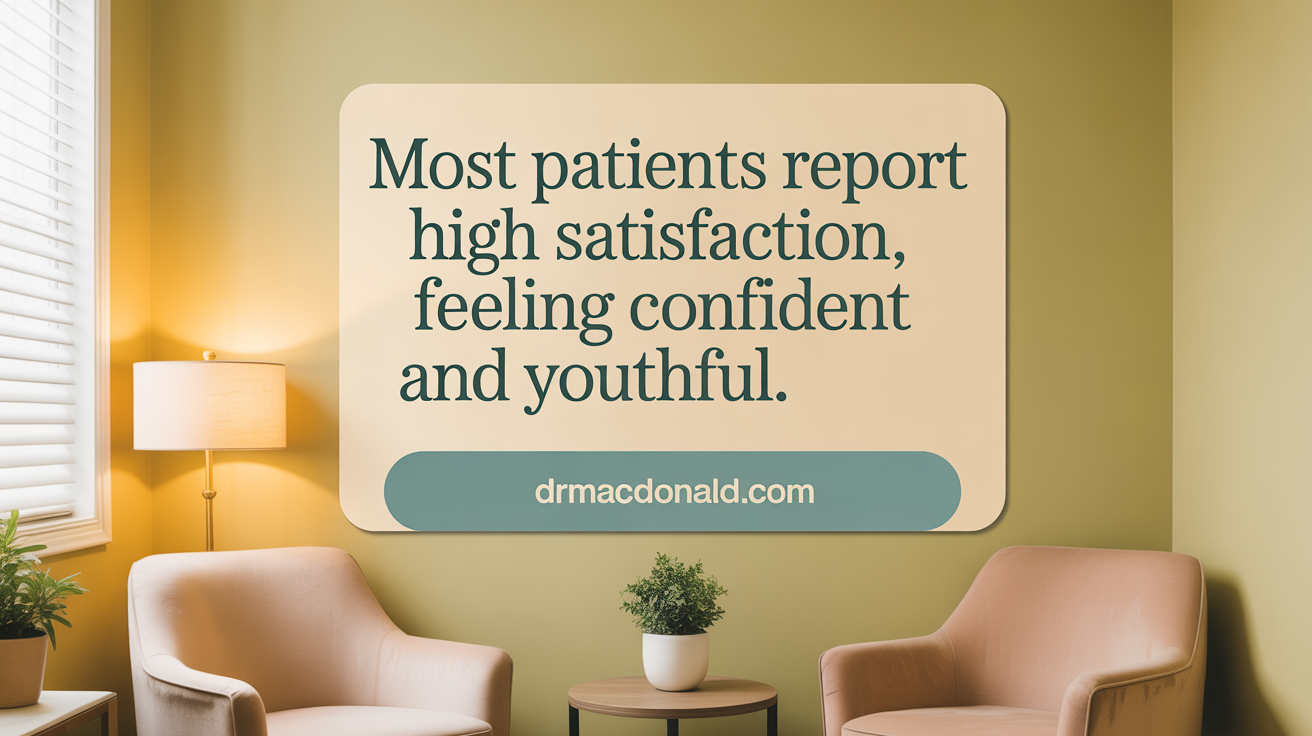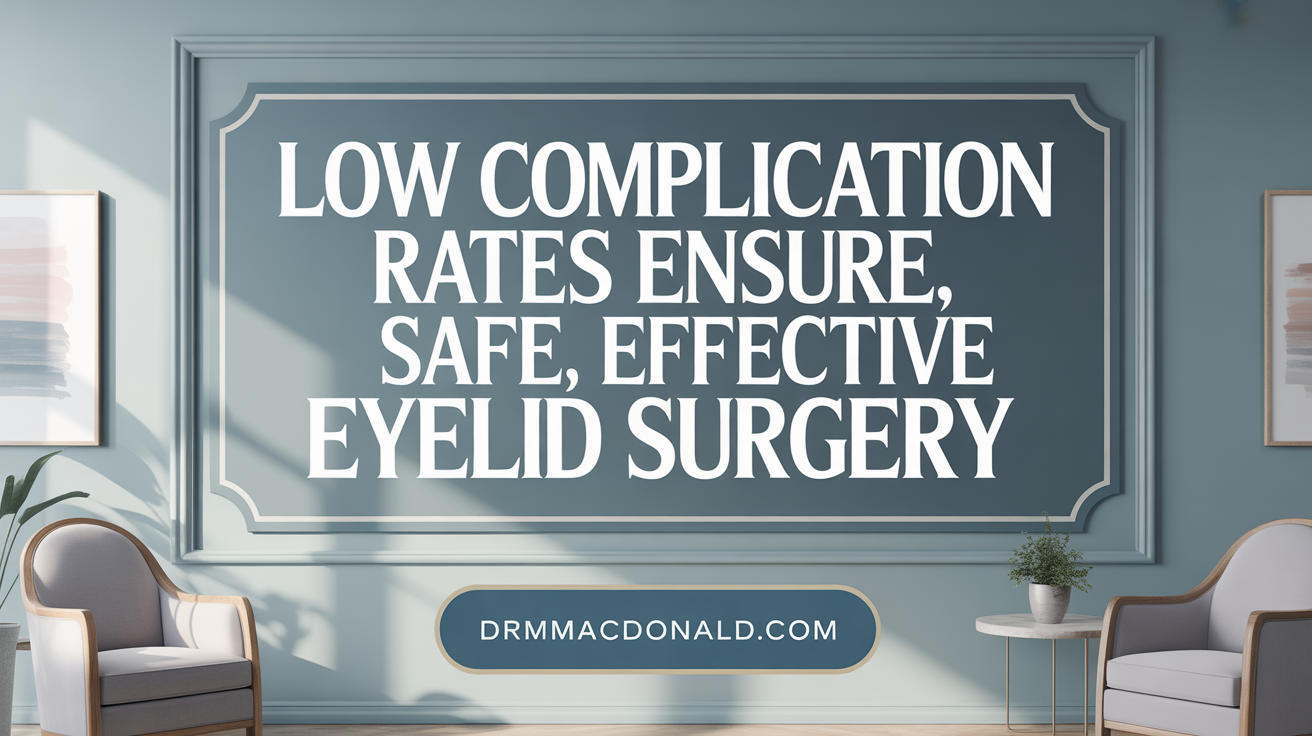Understanding Blepharoplasty Success Through Data
Blepharoplasty, or eyelid surgery, is a popular cosmetic procedure designed to improve both appearance and function of the eyelids. As patients seek reliable information before undergoing this surgery, exploring the statistics about its success rates, patient satisfaction, complications, and long-term outcomes provides critical insights. This article dives into 27 compelling statistics from clinical studies and patient reviews that shed light on what patients can expect from blepharoplasty.
Eyelid Surgery (Blepharoplasty) Key Facts
- Blepharoplasty has an overall success rate of 85-90%, with most patients experiencing significant aesthetic and functional improvements.
- Over 93% of patients report high satisfaction following upper blepharoplasty, often feeling more confident and youthful.
- Complications occur in less than 10% of cases, with common issues like swelling, bruising, and asymmetry usually resolving within weeks.
- Serious complications such as blindness are extremely rare, thanks to stringent surgical protocols and experienced surgeons.
- Temporary side effects, including bruising and swelling, typically resolve within two weeks, with gradual improvement.
- Scars from eyelid surgery usually fade within 6 to 12 months, with complete healing taking longer based on individual factors.
- Surgical duration for upper eyelid blepharoplasty generally lasts 45-60 minutes, depending on correction extent.
- Most patients return to normal activities within 10-14 days, following proper postoperative care.
- Results often last between 5 to 7 years, with some lasting a lifetime**, especially with good skin elasticity and surgeon skill.
- Patient satisfaction remains high regardless of technique, with no significant difference between skin-only and skin-muscle resection approaches.
1. High Overall Success Rate of Blepharoplasty
 Research shows that eyelid surgery has an overall success rate of around 85-90%, with many patients experiencing a noticeable improvement in eyelid appearance. The procedure effectively reduces sagging, bags, and excess skin, often lasting several years, sometimes even a lifetime. Its effectiveness is supported by objective measurements like tarsal platform show and brow fat span, which improve significantly after surgery, correlating positively with patient satisfaction.
Research shows that eyelid surgery has an overall success rate of around 85-90%, with many patients experiencing a noticeable improvement in eyelid appearance. The procedure effectively reduces sagging, bags, and excess skin, often lasting several years, sometimes even a lifetime. Its effectiveness is supported by objective measurements like tarsal platform show and brow fat span, which improve significantly after surgery, correlating positively with patient satisfaction.
2. Patient Satisfaction Exceeds 93%
 Studies show that over 93% of patients report high satisfaction after upper blepharoplasty. Many patients feel more confident, younger, and more rested following surgery. The positive effects include improved appearance, better vision, and relief from headaches or eyelid-related discomfort. These outcomes often lead to a significant boost in quality of life, with most patients happy with both aesthetic and functional results.
Studies show that over 93% of patients report high satisfaction after upper blepharoplasty. Many patients feel more confident, younger, and more rested following surgery. The positive effects include improved appearance, better vision, and relief from headaches or eyelid-related discomfort. These outcomes often lead to a significant boost in quality of life, with most patients happy with both aesthetic and functional results.
3. Complications Occur in Fewer than 10% of Cases
 The incidence of complications in upper blepharoplasty remains low, typically affecting fewer than 10% of patients. Common issues include temporary swelling, bruising, and asymmetry, which usually resolve within a few weeks. More serious complications are rare but may include infection, hematoma, or eyelid malposition. It's essential for patients to consult experienced surgeons to minimize these risks and ensure optimal outcomes.
The incidence of complications in upper blepharoplasty remains low, typically affecting fewer than 10% of patients. Common issues include temporary swelling, bruising, and asymmetry, which usually resolve within a few weeks. More serious complications are rare but may include infection, hematoma, or eyelid malposition. It's essential for patients to consult experienced surgeons to minimize these risks and ensure optimal outcomes.
4. Severe Complications Like Blindness Are Extremely Rare
 Severe complications such as blindness are very uncommon in blepharoplasty procedures. Although these risks exist, they are rare due to stringent surgical techniques and careful patient assessment. Prevention strategies include thorough preoperative evaluations, choosing experienced surgeons, and adhering to best practices during surgery. Most complications, if any, tend to be minor and temporary, ensuring high safety standards in eyelid surgery.
Severe complications such as blindness are very uncommon in blepharoplasty procedures. Although these risks exist, they are rare due to stringent surgical techniques and careful patient assessment. Prevention strategies include thorough preoperative evaluations, choosing experienced surgeons, and adhering to best practices during surgery. Most complications, if any, tend to be minor and temporary, ensuring high safety standards in eyelid surgery.
5. Temporary Side Effects Typical Within First Two Weeks
After blepharoplasty, most patients experience temporary side effects such as bruising and swelling. Bruising generally lasts about 10 to 14 days before fading. Swelling peaks in the first few days post-surgery and gradually diminishes over the next week or two. During this initial healing stage, visible signs of recovery include gradually improving eyelid contour and reduced puffiness. By the end of two weeks, many patients notice significant reduction in swelling, though minor residual swelling and bruising can persist for longer. Recovery progression involves a steady decrease in these symptoms, with full healing often taking several months.
6. Scars Can Take Several Months to Fade
Incision healing
After upper blepharoplasty, surgical incisions are carefully placed along natural eyelid creases to minimize visibility. Initially, the healing process involves inflammation and the formation of new tissue. Patients may notice redness, swelling, and minor discomfort as the incisions start to heal.
Scar fading timeline
Typically, scars from eyelid surgery are most noticeable in the first few months post-operation. Over time, these scars gradually fade, with visible improvements often seen within 6 to 12 months. Complete scar maturation and optimal concealment usually occur within a year or longer, though individual healing rates can vary.
7. Upper Blepharoplasty Surgery Duration Averages 45-60 Minutes
The typical duration for upper eyelid surgery, known as blepharoplasty, ranges from about 45 minutes to one hour. This procedure time can vary depending on the extent of correction needed. When performed separately, upper eyelid surgery usually takes less time compared to combined surgeries involving both upper and lower eyelids, which can extend to around two hours. The shorter duration of upper eyelid procedures makes them a convenient option for many patients seeking functional and aesthetic improvements.
8. Recovery Period Usually Lasts About One to Two Weeks
 After upper eyelid surgery, most patients feel comfortable going out in public within 10 to 14 days. During this period, swelling and bruising typically decrease significantly, though complete healing may take a few months. Postoperative care includes avoiding strenuous activities for about a week to facilitate recovery. Proper wound care and follow-up with the surgeon help ensure optimal results, and patients are encouraged to adhere to their surgeon’s instructions for a smooth healing process.
After upper eyelid surgery, most patients feel comfortable going out in public within 10 to 14 days. During this period, swelling and bruising typically decrease significantly, though complete healing may take a few months. Postoperative care includes avoiding strenuous activities for about a week to facilitate recovery. Proper wound care and follow-up with the surgeon help ensure optimal results, and patients are encouraged to adhere to their surgeon’s instructions for a smooth healing process.
9. Results Often Last Between 5 to 7 Years or Even a Lifetime
The longevity of results after upper blepharoplasty can vary, generally lasting between five and seven years, with some individuals experiencing benefits that last a lifetime. Factors such as surgical technique, patient age, and skin elasticity influence how long the improvements endure. While many patients enjoy enduring aesthetic and functional benefits, recurrence of droopy eyelids can occur, especially if underlying conditions or aging processes continue. Proper patient selection and surgeon expertise are crucial for maximizing long-term satisfaction. Overall, blepharoplasty offers a durable solution for eyelid concerns, often providing lasting improvements in appearance and vision.
10. No Significant Difference in Satisfaction Between Skin-Only and Skin-Muscle Resection
A recent randomized controlled trial involving 54 patients compared two common techniques in upper blepharoplasty: skin-only resection and combined skin/muscle resection. Both methods aimed to improve eyelid appearance and function, with patient-reported outcomes measured over 12 months.
Results indicated that satisfaction levels, as assessed by FACE-Q questionnaires, were similar across both groups across most parameters, including overall face, aging perception, social functioning, and satisfaction. Notably, at the 12-month mark, the only significant difference was higher scores for eye appearance in the skin-only group.
Objective assessments, like tarsal platform show and brow fat span measurements, improved significantly after surgery in both groups. The addition of muscle resection did not influence satisfaction or scarring, which remained comparable.
This suggests that including muscle removal in upper blepharoplasty may not be necessary, simplifying the procedure without compromising patient satisfaction.
11. FACE-Q Scores Increase Over Time After Surgery
Patients' perceptions of their eyelid surgery outcomes were measured using FACE-Q questionnaires at three points: before the procedure, and at 6 and 12 months post-operation. The results demonstrated that scores related to upper eyelids, overall face, aging, social interaction, and satisfaction improved gradually over time in both surgical groups. Notably, by the 12-month mark, patients who underwent skin-only resection reported slightly higher scores regarding their eye appearance. These findings highlight the positive impact of blepharoplasty on patient satisfaction, which increases as healing progresses.
12. At 12 Months Post-Surgery, Skin-Only Technique Yields Higher Eye Satisfaction Scores
A recent study comparing two upper eyelid surgery techniques revealed that, at the one-year mark, patients who underwent skin-only resection reported higher satisfaction specifically regarding the eye area compared to those who had combined skin and muscle resection. Overall patient satisfaction and perceptions related to aging, social functioning, and facial appearance improved over time, regardless of the technique.
Objective measurements such as tarsal platform show and brow fat span also demonstrated significant improvement post-surgery, especially among older patients over 55. These findings suggest that the simpler skin-only approach not only provides comparable aesthetic results but may also enhance patient-reported satisfaction concerning the eyes after a year.
These results highlight that additional muscle removal does not seem to influence long-term patient satisfaction, supporting the practice of opting for less invasive procedures when appropriate.
13. No Difference in Scarring or Adverse Effects Between Surgical Techniques
The study indicates that both skin-only resection and skin/muscle resection techniques for upper blepharoplasty exhibit similar safety profiles. Patients experienced comparable rates of scarring and adverse effects, with no significant differences observed between the two methods. Typically, postoperative scarring and side effects like swelling or bruising are temporary, resolving within a few weeks. These findings reassure that adding muscle resection does not increase complication risks or scar formation, supporting the use of either technique based on individual patient needs.
14. Objective Measures Show Significant Improvement Post-Surgery
Postoperative assessments using objective measurements revealed notable improvements. The Tarsal Platform Show (TPS) and Brow Fat Span (BFS) both showed statistically significant enhancements after surgery. These measurements suggest that anatomical changes achieved through blepharoplasty contribute to functional and aesthetic benefits, aligning with patient satisfaction and overall surgical success.
15. No Significant Eye Asymmetry Detected Before or After Surgery
The study observed no notable asymmetry in eye appearance before or after blepharoplasty, using precise symmetry measurements. Both procedures maintained consistent results, demonstrating surgical accuracy in producing balanced, natural-looking outcomes. This suggests that the surgical techniques employed effectively preserve facial symmetry, which is crucial for patient satisfaction and aesthetic appeal.
16. Older Patients (Above 55) Achieve Best Objective Results
Patients over the age of 55 tend to experience more significant improvements after upper blepharoplasty, especially in objective measurements like the tarsal platform show (TPS). Studies reveal a statistically significant enhancement in TPS values among older patients, indicating better structural and aesthetic outcomes. This age group often reports high satisfaction levels, correlating positively with the objective benefits observed.
17. Strong Positive Correlation Between Patient and Surgeon Satisfaction (r=0.704)
Patient satisfaction after upper blepharoplasty closely aligns with surgeons’ assessments, showing a strong positive correlation coefficient of 0.704 (p=0.002). This suggests that when surgeons achieve the desired aesthetic and functional outcomes, patients tend to report higher satisfaction levels. The alignment of expectations with surgical results plays a crucial role in overall contentment. Open communication about realistic goals before surgery is essential to ensure that both patient and surgeon are on the same page, ultimately leading to more favorable perceptions of the procedure’s success.
18. Patient Age Positively Correlates With Satisfaction Levels
Older patients, particularly those over 55 years, tend to report higher satisfaction after upper blepharoplasty. The study observed a positive link between age and patient satisfaction, with older individuals experiencing more significant improvements in both subjective and objective measures. This suggests that age plays a role in how patients perceive the outcomes, possibly due to baseline eyelid concerns being more pronounced or expectations aligning better with results in this age group. Therefore, demographic factors like age influence the overall success and patient contentment following eyelid surgery.
19. Objective Measurements Correlate Moderately With Patient Satisfaction (r=0.498)
Objective measures such as tarsal platform show (TPS) and brow fat span (BFS) were used alongside patient surveys to evaluate results. These physical measurements improved significantly after surgery, indicating successful tissue removal and shaping. Interestingly, there was a moderate positive correlation (r=0.498) between these objective results and patient satisfaction, suggesting that better measurable outcomes generally align with higher patient approval. While subjective satisfaction can vary based on personal expectations, combining objective and subjective assessments provides a comprehensive view of surgery success in blepharoplasty.
20. Enlarged Visual Field Is a Common Positive Outcome
Many patients experience a significant expansion in their visual field following upper blepharoplasty, which directly improves their ability to see peripherally. This functional enhancement is especially beneficial for those with droopy eyelids that previously blocked their sight. Objective measurements like the tarsal platform show and brow fat span demonstrate measurable improvements post-surgery.
21. Surgery Can Reduce Headaches Linked to Eyelid Sagging
Many patients experience relief from headaches caused by eyelid sagging after blepharoplasty, with studies showing improved symptoms in most cases. The procedure not only enhances appearance but also improves quality of life by reducing functional issues related to eyelid drooping.
22. Studies Show Blepharoplasty Improves Functional Visual Parameters Over Non-Surgical Management
Research indicates that eyelid surgery, or blepharoplasty, offers significant benefits over non-surgical approaches in improving visual function. Compared to conservative treatments like eyelid lifts with fillers or no intervention, blepharoplasty has shown to substantially expand the visual field, especially in cases of sagging eyelids obstructing peripheral vision. Studies report success rates of around 85-90%, with many patients experiencing not only aesthetic enhancements but also functional improvements such as reduced headaches and better vision. The procedure often results in long-lasting benefits, with effects persisting from five years up to a lifetime for some patients. Overall, blepharoplasty effectively addresses both appearance and functionality, making it a preferred choice for suitable candidates.
23. Preoperative Visual Field Tests Often Underestimate Postoperative Gains
Preoperative visual field tests may not fully capture the extent of improvement achievable after blepharoplasty. Surgeons often rely on these tests to assess eyelid function, but actual postoperative gains, such as enhanced peripheral vision and reduced eyelid obstruction, frequently surpass initial measurements. This discrepancy suggests that visual field testing prior to surgery can underestimate functional benefits, underscoring the importance of considering both objective tests and patient-reported outcomes in evaluating surgical success.
24. Reduction in Dry Eye Symptoms Reported Post-Surgery
Studies indicate that upper blepharoplasty can lead to improvements in ocular surface health, with some patients experiencing a reduction in dry eye symptoms. This enhancement is attributed to the removal of excess eyelid tissue, which helps improve eyelid function and ocular surface exposure. Statistics show that a notable number of patients report less dryness and discomfort following the procedure, contributing to increased comfort and better visual quality. Overall, blepharoplasty not only enhances appearance but also offers functional benefits such as alleviating dry eye symptoms for suitable candidates.
25. High Patient Satisfaction With Both Aesthetic and Functional Outcomes
Patients undergoing upper blepharoplasty report high satisfaction both aesthetically and functionally. The study found that satisfaction ratings improved over time in areas like the appearance of the eyelids, forehead, and overall face. Importantly, whether or not muscle was resected during surgery did not significantly affect patient-reported outcomes, indicating that simple skin removal often suffices. Strong correlations between patient satisfaction and objective measures, such as visual field improvements, highlight the combined benefit of aesthetic enhancements and functional gains like better vision and fewer headaches. Overall, these results underscore the procedure’s success in delivering lasting positive impacts on patients’ confidence, appearance, and quality of life.
26. Blepharoplasty Helps Patients Feel More Confident and Youthful
Patients often experience enhanced self-confidence and a more youthful appearance following eyelid surgery. According to studies, improvements in facial aesthetics lead to positive changes in social interactions and overall satisfaction. Many patients report feeling less aged and more energetic, which significantly boosts their quality of life.
27. Expert Surgeon Selection Significantly Increases Success and Minimizes Risks
Choosing an experienced and skilled surgeon is crucial for optimizing blepharoplasty outcomes and reducing potential risks. Studies demonstrate that surgeon expertise directly correlates with higher success rates—around 85-90%—and fewer complications such as asymmetry or undesirable scarring. Skilled surgeons are adept at customizing procedures to individual patient needs, ensuring better functional and aesthetic results. They also minimize risks like excessive swelling, bruising, or nerve damage, aiding quicker recovery. Ultimately, selecting a qualified professional significantly enhances the likelihood of achieving lasting, satisfactory results.
What Is the Success Rate of Blepharoplasty?
Blepharoplasty, or eyelid surgery, boasts a high success rate of about 85-90%, with many patients experiencing noticeable aesthetic and functional improvements. The procedure effectively addresses issues such as sagging skin, eyelid bags, and even visual field obstructions caused by excess skin. Most individuals report increased confidence, enhanced appearance, and easier vision after surgery.
Several factors influence the likelihood of a successful outcome. These include the surgeon's expertise, the patient’s overall health, and realistic expectations. Good health conditions like diabetes or hypertension can impact healing, while lifestyle factors such as smoking may slow recovery or affect results. Choosing a qualified surgeon skilled in eyelid procedures significantly increases the chances of satisfaction.
Recovery usually involves a period of swelling and bruising that diminishes within 10 to 14 days. Scars tend to fade over several months, and most patients return to normal activities after about two weeks. The results of blepharoplasty can last from five to ten years, with some experiencing enduring benefits, especially if they maintain healthy habits.
How Common Are Complications in Blepharoplasty, and What Are the Typical Risks?
Complications from blepharoplasty, or eyelid surgery, are relatively uncommon, with an overall incidence of about 9.5%. Most adverse effects tend to be mild and resolve within days or weeks.
Common issues include hematomas (collections of blood that cause swelling), which occur in roughly 0.5% of cases. Chemosis, characterized by swelling of the conjunctiva or the tissue lining the eye, is more frequent, affecting approximately 6% of patients. Lower eyelid malpositions such as retraction or ectropion—where the eyelid turns outward—are seen in about 0.5% to 2.5% of procedures.
Severe complications, although rare, can include vision loss resulting from orbital hemorrhage or vascular injury during surgery. These serious events typically require immediate medical attention and intervention.
Proper surgical planning, careful patient selection, and skilled execution are essential in minimizing risks. Surgeons often conduct thorough preoperative assessments to identify potential factors that could complicate surgery.
Most adverse events are manageable with conservative treatments, such as medications and minor corrective procedures. High patient satisfaction tends to follow successful, well-managed surgeries, emphasizing the importance of experienced surgical care.
What Is the Patient Satisfaction Rate Following Blepharoplasty?
Patient satisfaction following eyelid surgery, or blepharoplasty, is notably high according to recent survey data. An analysis of nearly 2,000 reviews revealed that approximately 93.7% of patients reported overall positive outcomes after the procedure. The vast majority, about 93.5%, considered their surgery to be "worth it," reflecting a strong sense of value and satisfaction from the results.
These positive assessments are supported by studies showing a close correlation between patient-reported satisfaction and surgeon assessments. Interestingly, satisfaction levels tend to increase over time, with significant improvements noted at 6 and 12 months post-surgery. Patients often cite benefits such as enhanced visual fields, improved appearance, and boosts in confidence. For a comprehensive overview, searching "Patient satisfaction after eyelid surgery statistics" provides additional detailed data.
What Are the Typical Outcomes and Healing Timeline After Eyelid Surgery?
What are the typical outcomes and healing timeline after eyelid surgery?
Eyelid surgery, also known as blepharoplasty, generally provides long-lasting improvements in eyelid appearance. Most patients can expect to look presentable to the public within approximately 10 to 14 days after the procedure.
The initial healing period involves swelling and bruising, which gradually diminish over the first two weeks. It's common to see significant reduction in these symptoms as the tissues settle. However, some residual swelling and final tissue adjustments may take several months, usually up to six months, to fully resolve.
Patients often report feeling more confident and seeing functional benefits such as improved vision and reduced headaches. The surgery can also lead to enhanced visual fields, especially when excess skin blocks peripheral vision.
Proper postoperative care is crucial for optimal healing. This includes protecting incisions from excessive movement, avoiding sun exposure, applying prescribed medications, and following surgeon advice closely.
While most outcomes are positive, individual results can vary based on age, skin quality, and overall health. Occasionally, additional procedures may be needed to achieve the desired aesthetic or functional result.
Healing phases
- First Week: Swelling and bruising are most prominent. Patients are often advised to rest, keep the head elevated, and avoid strenuous activities.
- Weeks 2-4: Swelling and bruising lessen significantly. Most patients feel comfortable returning to social activities.
- Months: Residual swelling continues to diminish. Scars begin to fade, and the final appearance becomes evident.
- Up to 6 Months: Complete healing and tissue settling occur.
Visible results timeline
- Within 2 Weeks: Initial results visible; most swelling and bruising gone.
- 1-3 Months: Results become more refined; scars fade.
- 6 Months and Beyond: Final results and optimal healing.
Postoperative care essentials
- Follow surgeon's instructions regarding wound care.
- Use eye protection from sun exposure.
- Avoid strenuous activities for at least a week.
- Attend all follow-up appointments.
- Report any unusual symptoms like persistent pain, significant vision changes, or signs of infection.
Adherence to post-surgical guidelines helps ensure a smooth recovery and lasting, satisfying results.
Summary of Eyelid Surgery Success and Patient Outcomes
Blepharoplasty boasts high success and patient satisfaction rates supported by numerous clinical studies and patient-reported data. With a success rate hovering around 90-95%, the procedure delivers both aesthetic enhancement and functional benefits, such as improved visual fields and symptom relief. Complications remain uncommon and manageable, particularly when surgery is performed by experienced, qualified surgeons. Objective measurements and subjective satisfaction metrics strongly align, further validating the procedure’s effectiveness. Patients typically see substantial improvements within weeks, with results potentially lasting many years or even a lifetime. Choosing a skilled surgeon and maintaining realistic expectations are essential to maximizing the benefits. Ultimately, blepharoplasty remains a reliable surgical option for those seeking youthful, refreshed eyelids and enhanced quality of life.
References
- Patient-reported aesthetic outcomes of upper blepharoplasty
- (PDF) Evaluation of upper blepharoplasty outcome-objective ...
- What is the success rate of eyelid surgery?
- Functional outcomes of upper eyelid blepharoplasty: A systematic ...
- Blepharoplasty - Mayo Clinic
- Blepharoplasty (Eyelid Surgery): What It Is, Details & Recovery
- Eyelid Surgery Results - American Society of Plastic Surgeons
- Eyelid Surgery Procedure Steps | American Society of Plastic ...
- Eyelid Surgery Risks and Safety
